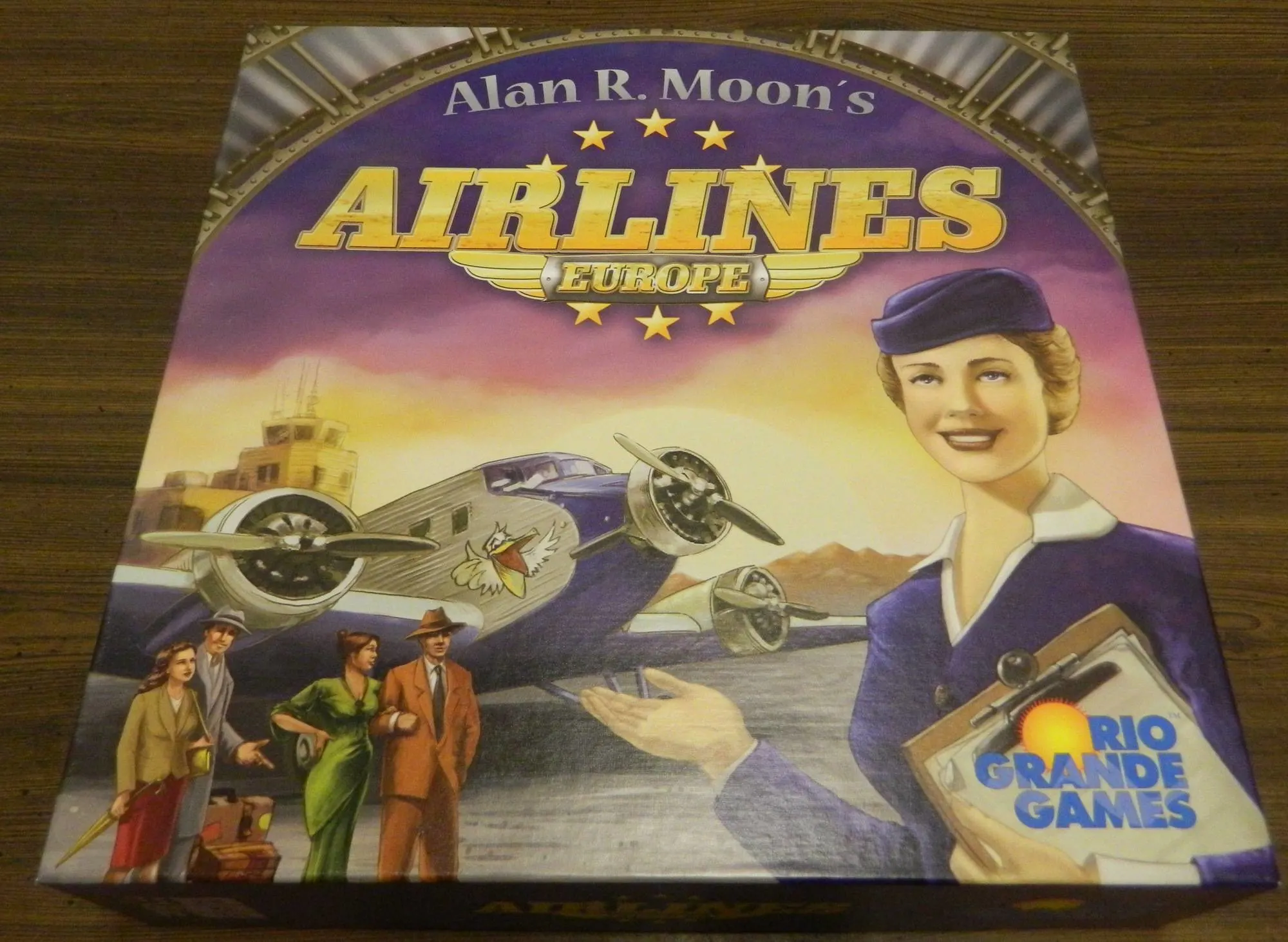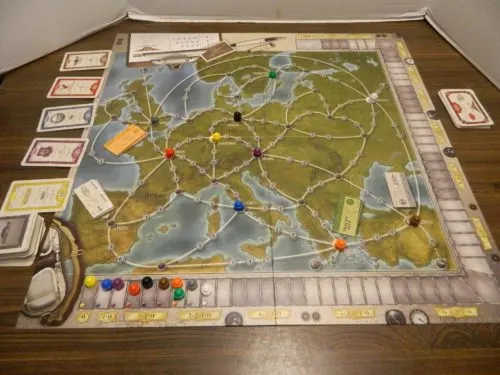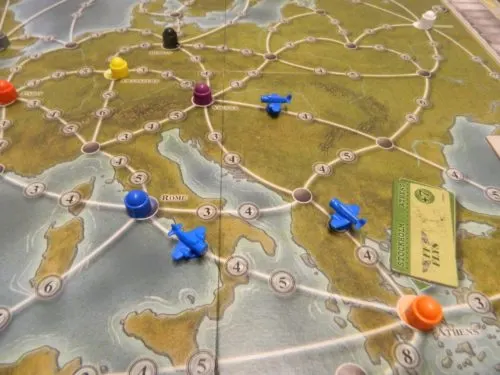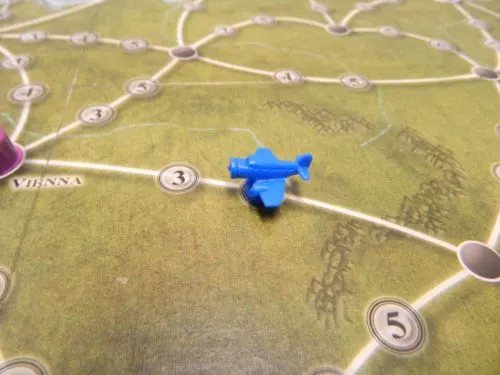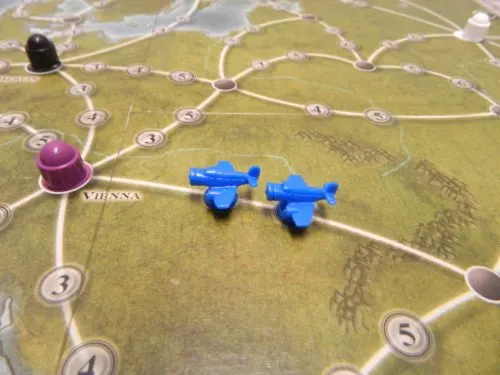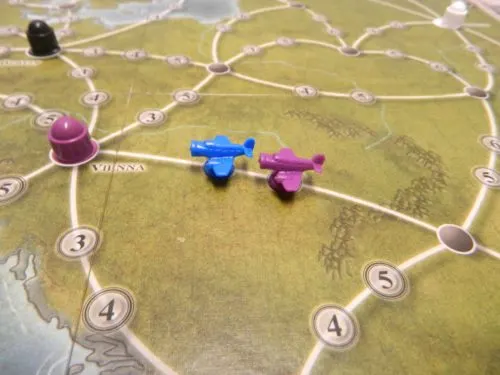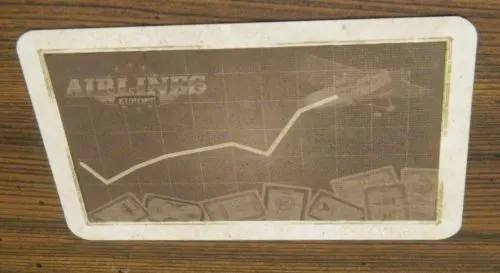Long time readers of Geeky Hobbies probably already know this but one of my favorite board game designers is Alan Moon. I have played quite a few games made by Alan Moon and I have enjoyed every single one of them. It also doesn’t hurt that he made my favorite board game of all time, Ticket to Ride. So far on Geeky Hobbies we have looked at eight different games designed by Alan Moon: 10 Days in Africa, 10 Days in the USA, Elfenland, Incan Gold, Skyline 3000, Ticket to Ride Europe, Ticket to Ride Marklin, and Walk the Dogs. Since I have liked so many of Alan Moon’s other games I was excited to try out Airlines Europe as it is generally regarded as one of Alan Moon’s best games. While Airlines Europe does not quite reach the levels of Ticket to Ride, it is another fantastic combination of accessible gameplay with a satisfying amount of strategy.
How to Play Airlines Europe
Setup
- Depending on the number of players you may not use the components for all of the airlines:
- 5 players: Use all of the airlines.
- 4 players: Use all of the airlines except for yellow.
- 3 players: Use all of the airlines except for yellow and violet.
- 2 players: Use all of the airlines except for the yellow, blue, and violet.
- Place the gameboard in the middle of the table. Put a company marker on the home airport of each airline. Also place a company marker on the corresponding spaces on the scoring track. Place the bonus connection markers on the corresponding spots on the gameboard.
- Place the victory tokens next to the gameboard and sort the airplanes by color. Place the 20 share cards for Air ABACUS to the side of the gameboard.
- Players choose a starting player. The starting player gets one victory point. The second player gets two victory points and each subsequent player gets one more victory point than the previous player.
- Take 30 million Euros for each player in the game to form the bank. All extra money is set off to the side and is not used in the game. Each player is given 8 million Euros.
- Each player takes a game summary card to reference throughout the game.
- Remove the three scoring cards from the deck and set them off to the side. Shuffle all of the other cards and place the top five cards on the appropriate spots on the gameboard to form the stock market. Each player is then dealt eight cards for their starting hand. Each player chooses two of the cards from their hand (from different airlines). All of the players reveal their cards at the same time and the cards are placed face up in front of them to form their share portfolios.
- To form the share card supply deck the players will follow several steps. First take the top ten cards from the deck and shuffle them with one of the scoring cards. These eleven cards form the bottom of the stack. Take a fourth of the cards and set them to the side as they will be the top of the stack. Place the second scoring card in the middle of the remaining set of cards. Place the third scoring card on top of the same stack. This stack is then placed on top of the cards that form the bottom of the stack. Finally the top stack that was set aside is placed on the top of the stack.
Playing the Game
On a player’s turn they can take one of four different actions:
- Buy one or two route licenses and take a share card.
- Play share cards and take a dividend.
- Acquire Air ABACUS shares.
- Take 8 million Euros from the bank.
Buy Route Licenses
On a player’s turn they can buy one or two different route licenses. When buying a route license a player can purchase it for any of the airlines. A player does not need to have a share of the airline to purchase a route license for it. To purchase a route license a player has to pay the cost (the number printed on the circle) to the bank and will then get to place an airplane of their chosen airline on the route they purchased. The player also moves the company marker of the airline forward as many spaces as they paid for the route.
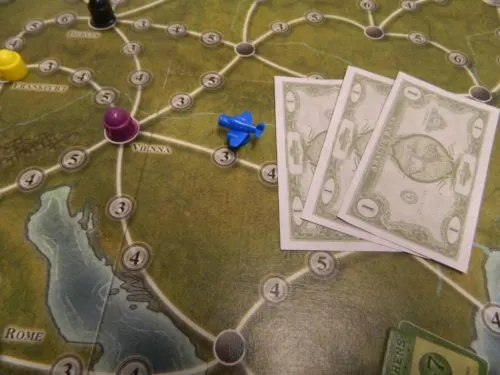
This player has purchased a route for the blue airlines for 3 million euros. The player will move the scoring marker for the blue airlines forward three spaces.
When purchasing routes players have to follow a couple rules:
- Any routes purchased for an airline have to be connected to the airline’s home airport either directly or through other routes already purchased for the airline.
- A player always has to buy the cheapest available license for a route they want to buy.
- Each airline can only purchase one of the licenses for each route.
- If all of the licenses have been purchased for a route, no other airline may purchase a license for that route.
- When an airline no longer has anymore airplanes, they can no longer purchase additional routes.
After purchasing a route(s) the players check to see if any of the airlines have completed their bonus connection. If the airline has formed a continuous path between their home airport and the target destination, the airline scores the bonus points indicated on the destination marker.
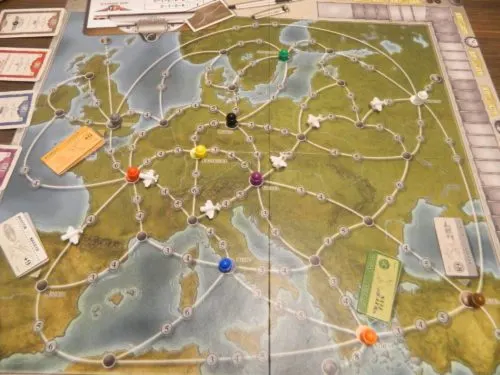
The white airline has completed a route from Moscow to Madrid. The white airline gets the nine bonus points for completing the route.
Once a player has purchased one or two licenses, they are able to take one share card. They can either take one of the face up share cards from the stock market or they can take the top card from the supply deck. The card that is taken is added to the player’s hand. If a card is taken from the stock market a new card is taken from the top of the supply deck to fill its’ spot in the stock market.

The players can currently choose between taking one of the face up shares or they can take the top card from the share deck.
Play Shares
A player can use their turn to play share cards from their hand. When playing cards a player can either:
- Play as many cards as they want from one color.
- Play one card from two different airlines.
Cards that are played are placed face up in front of the player in their portfolio. Players should sort the cards in their portfolio by color so everyone know how many shares each player controls of each color. The player also takes 2 million Euros for each share card they played.
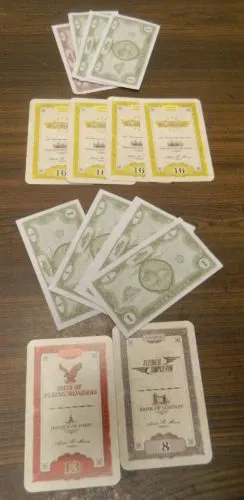
The top player played four yellow shares and received 8 millions Euros. The bottom player played one share from two different airlines for 4 million Euros.
Acquire Air ABACUS Shares
A player can use their turn to acquire one or two shares of Air ABACUS. To acquire one share a player has to either discard one card from their hand or from their portfolio. The card that is discarded is removed from the game. To acquire two shares of Air ABACUS a player has to discard three shares either from their hand or their portfolio.
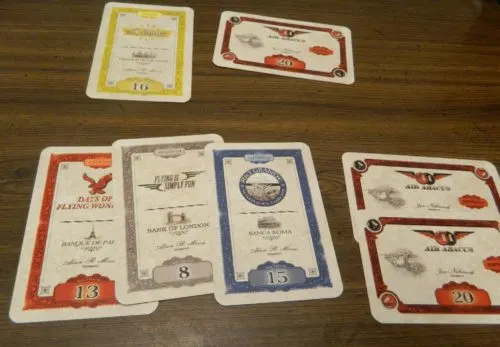
The top player traded one share card for one share of Air Abacus. The bottom player traded three shares for two shares of Air Abacus.
Bank Bankruptcy
If at any time the bank runs out of money, the bank has gone bankrupt. When the bank goes bankrupt players count up how much money they currently have. Any player that has more than 8 million Euros has to give all of their money above 8 million Euros back to the bank. All of the share cards in the stock market are removed from the game and five new cards form the stock market.
Scoring
When one of the three scoring cards are drawn from the supply deck, the game temporarily stops as scoring will be conducted. The scoring card is given to the player to the left of the current player. If the player took the scoring card from the supply deck, they draw the next card from the supply deck for their hand. If the card was to fill in the stock market a new card is draw to fill in the stock market.
Starting with the player who has the scoring card in front of them, each player gets to take one card from the stock market. No additional cards are added to the stock market after each card is taken. After each player has taken one card, any cards left in the stock market are discarded. The stock market is then refilled with cards from the top of the supply deck.
Players then start scoring each of the airlines individually. Players start with the airline furthest along the scoring track.
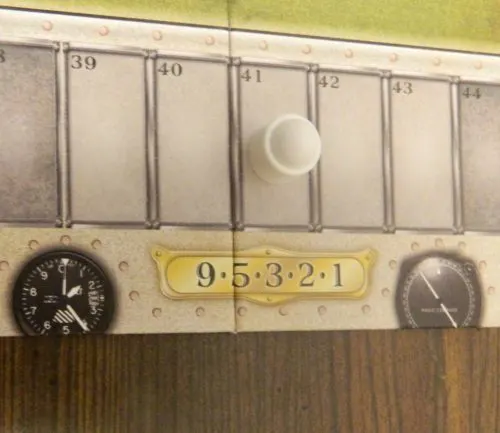
The white airline has reached the 9-5-3-2-1 scoring zone. The player with the most shares will receive nine points. The player with the second most shares will score five points and so on.
For each airline the players compare how many cards they have in their portfolio (played to the table and not the cards in their hands) for that airline. The player with the most cards for the airline, receives victory points equal to the largest number for the section that the airline’s marker is in. The player with the second most cards for the airline scores the second largest number of victory points and so on. If a player has no shares for the airline they are unable to score points for that airline. If two or more players are tied for one of the positions, the points for the next positions (equal to the number of tied players) are added up and evenly distributed. If there is an uneven number of points, the number of points are rounded up so each player receives the same number of points.
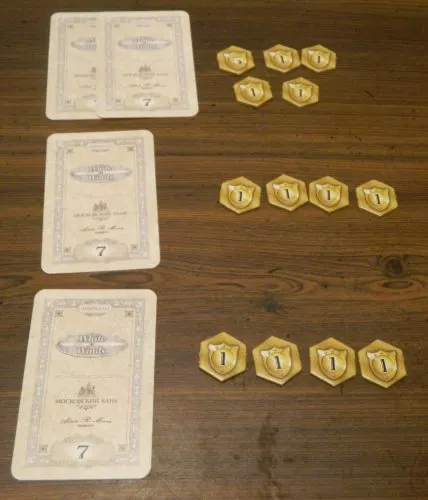
The top player has the most white shares so they will receive nine points. The other two players tied for second place so they will both receive four points which is the reward for second and third place (5+3) divided by two.
After all of the airlines have been scored, players will score Air ABACUS. The number of points rewarded for Air ABACUS depends on which scoring card was drawn.
- 1st Scoring Card: 4-2-1-0 points
- 2nd Scoring Card: 8-4-2-1-0 points
- 3rd Scoring Card: 16-8-4-2-1 points
If this wasn’t the third scoring period, play resumes as normal.
End of Game
The game ends immediately after the third round of scoring. The game can also end immediately if none of the airlines can purchase additional licenses. The player with the most victory points wins the game. If two or more players have the same amount of victory points, the player with more Air ABACUS shares wins the game. If there is still a tie, the players share the victory.
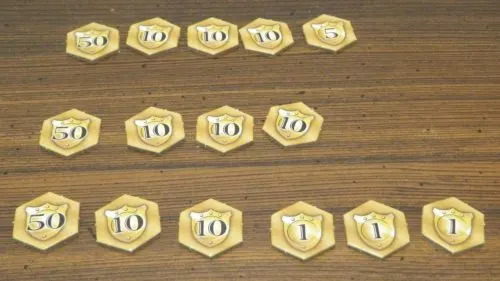
The top player has scored 85 points, the middle player has scored 80 points, and the bottom player has scored 73 points. Since the top player has scored the most points they have won the game.
My Thoughts on Airlines Europe
To begin I would like to say that Airlines Europe has an interesting backstory. One of Alan Moon’s first board games was Airlines which was published in 1990. Nine years later Alan Moon released Union Pacific which took some of the ideas from Airlines and tweaked them to turn them into a train game. Finally twelve years after Union Pacific Alan Moon decided yet again to tweak the formula taking elements from both Airlines and Union Pacific to create today’s game Airlines Europe. I am kind of curious to see how the different mechanics of Airlines Europe were developed through Airlines and Union Pacific but unfortunately I have never played either game so I won’t be able to compare Airlines Europe to either of them.
Having played quite a few different Alan Moon games there seems to be one thing that all of his games share in common. A trademark of most Alan Moon games seems to be that they are accessible to people that don’t play a lot of board games and yet still contain a surprising amount of strategy beneath the surface. The reason I like Alan Moon’s games so much is that I am a firm believer in there being no reason to make a game more complicated than it has to be. Not surprisingly Airlines Europe continues the trend of creating accessible yet surprisingly deep games.
I would say that one of the first “designer” games that I ever played was the original Ticket to Ride. Ticket to Ride is one of the best introductory designer games that you can use to introduce people to more “sophisticated” board games. Ticket to Ride is such a perfect introductory game since the game has only a couple mechanics and the mechanics for the most part are pretty straightforward. When I compare Airlines Europe to Ticket to Ride, I would say that it another small step towards more difficult designer games. Now don’t get me wrong, Airlines Europe is far from a difficult game. It just takes a while longer to get a hang of than Ticket to Ride. I would say that it should take around 10-15 minutes to teach the game to most new players.
Like most games, Airlines Europe does have some reliance on luck. Getting access to the right stock cards at the right times is crucial. If a player never gets the share cards that they want, they are going to have a hard time winning the game. There is also some luck with regards to timing. A key to doing well is being able to time when the next scoring phase is going to come. Missing out on performing one more action before a scoring phase can lose a player quite a few points. While luck will have some impact on your fate in the game, I think strategy plays a much bigger role.
Just like with Ticket to Ride and Alan Moon’s other games, there is more beneath the surface than you would initially think. While there are only four different actions that players can take on their turn, those four actions actually give players quite a few different options. While you could play the game without putting a lot of thought into your moves, you likely aren’t going to win the game without a strategy. Without a strategy you may end up helping your opponents more than you help yourself.
While Ticket to Ride and Airlines Europe feel similar to one another, one of the areas where Airlines Europe seems to differ the most from Ticket to Ride is the fact that the game relies a lot more on being able to read your opponents. In Ticket to Ride the only real reason you have to read your opponents is to avoid having another player take a connection that your really need. Knowing what your opponents are going to do is quite a bit more important in Airlines Europe. I think the key to doing well in Airlines Europe involves controlling the margins as well as taking advantage of the other players actions.
Lets start with controlling the margins. The biggest key to success in Airlines Europe is margins. In order to do well in Airlines Europe you need to know when you need to strengthen your position in a company and when you need to back off. Your ultimate goal is to have one more share of an airline than all of the other players. It doesn’t matter if you have one more share or ten more shares since you will still receive the same reward. Instead of wasting time solidifying a position that you already comfortably hold, you want to strengthen your position in many different airlines so you can slightly beat out another player for a position. If you only focus on having a dominate lead in one company, you probably aren’t going to do well in the game.
This leads me to the other key to the game, taking advantage of the other players actions. Basically if you go at it alone building up your own airlines, you aren’t going to score a lot of points. Instead you want to have a position in a lot of different companies since every time another player makes an airline more valuable, they are also giving you more points. If you can get a solid foothold in an airline that a lot of other players are upgrading, you can get quite a few additional points doing nothing. Then while the other players are giving you free points, you can focus on upgrading airlines that none of the other players are interested in.
While I really liked Airlines Europe, it doesn’t quite live up to Ticket to Ride. I had a blast with Airlines Europe but if you gave me the option between playing a game of Ticket to Ride or Airlines Europe, I would probably choose Ticket to Ride a majority of the time. I think the main reason I prefer Ticket to Ride is that the strategy is more straightforward. While you can never truly know what the other players are going to do on their turn, it feels like you have more control over your fate in Ticket to Ride. Your basic goal is to try and complete routes connecting the cities on your ticket cards. While players can block the path you wanted to take, you always know what your objective is and can still find ways to achieve your objective.
The biggest issue I had with Airlines Europe is that you don’t always know what action is best for you on a given turn. During most players first game they might not exactly know how to approach the game until half way through. Airlines Europe relies more on trying to figure out what the other players are going to do. To be successful you really can’t focus on doing your own thing as you will have a hard time winning the game with that strategy. You really need to rely on reading the other players’ intentions so you can take advantage of their actions to help yourself.
Other than it not always being obvious what the best strategy is for a given situation, Airlines Europe has a couple other small issues.
I was actually a little surprised that each turn in Airlines Europe shouldn’t always be maximized. I am the type of player that always wants to maximize every single turn. After a while though I started to realize that this is not always the best strategy in Airlines Europe. The game has a couple areas where it is not always in your best interest to do as much as you can on a given turn. In general you would think it would be best to purchase two routes on your turn as you can do two things instead of one. It actually seems to be more valuable to buy one route each turn since you can get more cards and preserve more of your money. I also thought it would be best to try and get a bunch of cards of the same color so you could play a lot of cards on the same turn. While playing more cards on your turn is nice, I actually found it to be more useful to play two cards of different colors since it makes it easier to build slight advantages over the other players.. Finally I was hesitant to give up a turn in order to take the 8 million Euros since I am a player that never likes to give up a turn for money. It turns out that taking the 8 million Euros is actually a valid action since the extra money gives you quite a bit of flexibility. While every turn in Airlines Europe is still important, I was surprised that it is not always the best to try and maximize every single turn.
Another small issue I had with the game is something that I have with a lot of these type of games. At times I actually found it hard to keep track of whether an airline’s value was increased after a route was purchased. Just like you will occasionally forget to give a player their points for a route in Ticket to Ride, you will occasionally forget to move an airline’s piece around the track when a new route is purchased. This could lead to some players making some decisions that they otherwise wouldn’t have made. The good news though is that just like Ticket to Ride it is actually quite easy to determine whether the markers are on the right spot by counting up the points before each scoring period. My group tends to double check each marker before scoring is conducted to make sure there are no errors when scoring.
In general I am not a big fan of cutthroat mechanics in games and yet I think Airlines Europe might be a little too lenient on the players. In a four player game it is really hard to ever block off an airline preventing them from claiming additional routes. The board has so many different routes that it is really hard to truly block off an airline as long as one player cares enough to prevent it from being surrounded. While I think Airlines Europe would have suffered if it was too easy to cut off other airlines, I think the game should have made it a little easier to do so.
So before wrapping up I want to make a few comments about Airlines Europe’s components. Like the Ticket to Ride games I really like the components included with Airlines Europe. The components actually remind me quite a bit of Ticket to Ride despite the two games being made by different companies. In particular I really liked the mini planes. The artwork is nice and straightforward like a lot of Alan Moon games. I really like that all of the airlines have names that allude to other board game publishers. The only real complaint I have with the game’s components are that some of the colors are somewhat hard to tell apart. Part of that is because the game had to use ten different colors. Even if you aren’t color blind it is sometimes hard to tell some of the colors apart. I can’t imagine how hard it would be for people that are color blind.
Should You Buy Airlines Europe?
Being a huge fan of many of Alan Moon’s other games, I had high expectations for Airlines Europe. For the most part I wasn’t disappointed either. While Airlines Europe is not as good as Ticket to Ride, it feels a lot like it. I would probably say Airlines Europe is Alan Moon’s second best game that I have played. Just like with Alan Moon’s other games, Airlines Europe succeeds at being accessible and yet still having quite a bit of strategy hiding beneath the surface. Despite not having a lot of mechanics the game gives players quite a few options. The key to doing well in the game is trying to control the margins in many different companies. Outside of some minor complaints the only real issue I had with Airlines Europe is that it takes a while to fully grasp how to approach the game’s strategy and you don’t always know what you should do since you don’t know what the other players are going to do. Otherwise there really isn’t a lot of complain about when it comes to Airlines Europe since it is a great game.
If you and your group are more interested in light or heavy board games, Airlines Europe is probably not going to be for you. Also if you aren’t a big fan of Ticket to Ride, while Airlines Europe plays quite differently it might not be for you. If you like other games made by Alan Moon though or like light-moderate to moderate strategy board games, I think you will really enjoy Airlines Europe. I know I enjoyed the game and I would recommend that most people pick it up.
If you would like to purchase Airlines Europe you can find it online: Amazon, eBay

